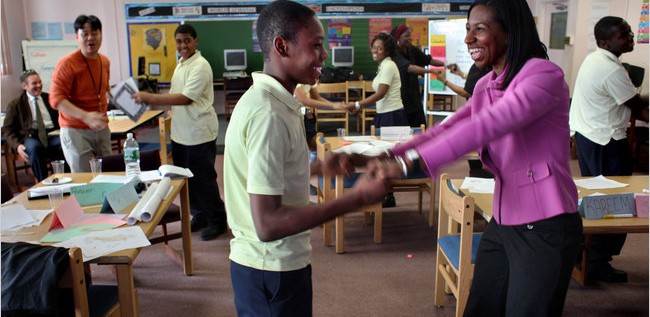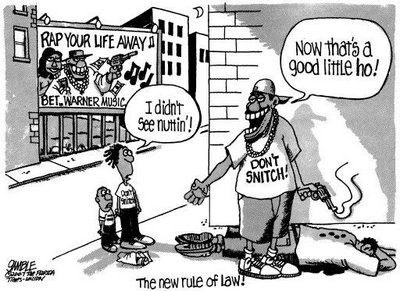Teacher Training, Taught by Students


Syidah O’Bryant scribbled notes in a composition book, trying to keep up with a lesson about why teenagers are so sleepy in the morning.
Usually Ms. O’Bryant, an eighth-grade social studies teacher, is the one talking. But on Tuesday, it was her student, Kare Spencer, 14.
“She’s the boss of me; she’s teaching me,” Ms. O’Bryant said.
In a role reversal, Ms. O’Bryant and other teachers at Brick Avon Academy are getting pointers from their students this year as part of an unusual teacher training program at 19 low-performing Newark schools.
The lesson learned by Ms. O’Bryant? “It makes you think about really hearing the kids,” she said. “You can learn from them. They have their own language.”
The training program, which is supported by a federal grant, is being run by the National Urban Alliance for Effective Education, a nonprofit group based in Syosset, N.Y. During a daylong workshop, teachers were instructed by the group‘s trainer, Eyka Stephens, to watch their students teach mock lessons, study their methods and language, and discuss together what works (and what does not).
The half-dozen students who participated told their teachers that they learned better when they could move around, interact with classmates and use computers and the Internet – prompting Ms. O’Bryant to joke that she should find a way to give tests on Facebook.
But afterward, the teachers said they saw ways to incorporate the students‘ ideas into their teaching methods. Wanda Davis, 53, a science teacher, said that she planned to have her students stretch before tests, and play a musical-chair-like game she had learned at the training session, in which students paired off when she called “stop,” as a way, she said, “to build a sense of community in the classroom.”
“The more they can tell you about what interests them, what motivates them, the more you can gear the lesson to their needs,” she said.
The idea of using students to help teachers sharpen their skills came from the National Urban Alliance‘s trainers, who, while working with Newark’s teachers, observed how easily students on the playground seemed to teach one another the latest dances or games.
“It’s just so natural for them,” said the group‘s chief of staff, Ahmes Askia, who oversees the Newark program. “Their friends get it, and they get it almost effortlessly, so we’re saying to the teachers: use that in the classroom.”
The idea is getting some traction. Joint student-teacher training has spread to schools in San Francisco; Bridgeport, Conn.; and East Allen County in Indiana.
In Greene County in Georgia, high school students assigned to attend school on a Saturday because they had been tardy were recruited to participate in a teacher training session.
In Yonkers, the school district included 250 students in “learning labs” for teachers last summer, as a way to give teachers ideas to improve techniques and to give students enrichment – in subjects like science, math and technology – despite budget cuts.
And Eric Cooper, president of the National Urban Alliance, said his group had received inquiries from education foundations and state education departments.
Newark, which is searching for a new superintendent amid renewed efforts to turn around its failing schools and improve student achievement, will soon have more students involved in teacher training. The Newark Teachers Union plans to include high school students in a professional development program on Saturday that it and a foundation are sponsoring.
Joseph Del Grosso, the union president, said he learned the value of student input as a fourth-grade teacher in Newark in the late 1970s. While he received high marks from administrators, he said, students complained that they did not understand his math lessons.
“The one thing about elementary school kids is that they’re very honest,” he recalled. “It made me feel bad, but I figured I needed to do better.”
Mr. Del Grosso said he sought help from other math teachers, started using more visual aids to illustrate abstract concepts and even incorporated chess into math lessons. It worked, he said – to the point where some students started beating him at chess.
At Brick Avon Academy, a low-performing school that was turned over to a group of former Teach for America teachers to run this year, the training workshops have invigorated the staff and the students. The training is required for teachers in the sixth through eighth grades; students are selected at random.
Assata M. Wilson, 13, an eighth grader, said she felt important because her teachers wanted to hear what she had to say. Too often in class, she said, there was no time for that. “They’re teaching us, so it helps them to know how we’re thinking,” she said.
Daniel Lu, a special-education teacher, said that the workshops provided him with a road map to give students more independence while keeping them on task.
“As a teacher, it’s really hard to give up control of your classroom,” he said. “I think we have to trust our students more to work together.”
For Ms. O’Bryant, 35, the workshops have reinforced her belief that students can learn best when they are teaching one another. When she is the only one running lessons, she said, students sometimes tune out or do not pick up the material, no matter how many times she repeats it.
“When we went to school, we would sit down and listen,” she said. “Now you’ve leveled the playing field. It’s not always what Ms. O’Bryant says.”




